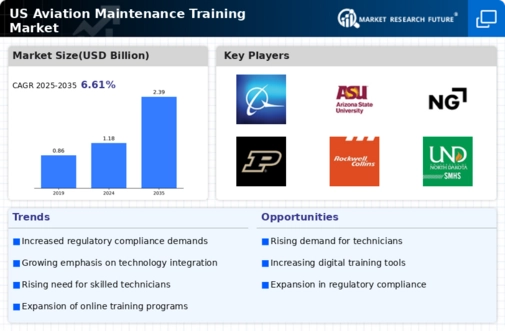Increased Focus on Safety Standards
Safety standards play a pivotal role in shaping the aviation maintenance-training market. Regulatory bodies, such as the FAA, continuously update safety regulations to ensure the highest levels of safety in aviation operations. This focus on safety necessitates that maintenance personnel receive comprehensive training that adheres to these standards. As a result, training programs are being designed to incorporate the latest safety protocols and practices. The aviation maintenance-training market is thus compelled to evolve, ensuring that technicians are well-versed in current safety regulations. This emphasis on safety not only enhances the quality of training but also instills confidence in the aviation industry, potentially leading to increased enrollment in training programs.
Rising Demand for Skilled Technicians
The aviation maintenance-training market is experiencing a notable increase in demand for skilled technicians. As the aviation industry expands, the need for qualified personnel to maintain and repair aircraft becomes critical. According to the Federal Aviation Administration (FAA), the aviation sector is projected to require approximately 190,000 new technicians by 2030. This growing demand is driving educational institutions and training organizations to enhance their programs, ensuring they meet industry standards. The aviation maintenance-training market is thus positioned to benefit from this trend, as more individuals seek certification and training to enter this lucrative field. The emphasis on hands-on training and real-world experience is likely to attract more students, further fueling the growth of the market.
Collaboration with Industry Stakeholders
Collaboration between educational institutions and industry stakeholders is becoming increasingly vital in the aviation maintenance-training market. Partnerships with airlines, manufacturers, and maintenance organizations facilitate the development of training programs that align with industry needs. These collaborations often result in internships and job placement opportunities for students, enhancing their employability upon graduation. The aviation maintenance-training market is likely to benefit from these synergies, as they ensure that training curricula remain relevant and up-to-date. Furthermore, industry input can help shape the skills and competencies that are most sought after, thereby attracting more students to pursue careers in aviation maintenance.
Government Support and Funding Initiatives
Government support and funding initiatives are crucial drivers of the aviation maintenance-training market. Various federal and state programs aim to promote workforce development in the aviation sector. For instance, grants and funding opportunities are available for training institutions to enhance their facilities and programs. The FAA and other governmental bodies are actively involved in initiatives that encourage the growth of the aviation workforce. This support not only helps to improve training quality but also makes aviation maintenance training more accessible to a broader audience. As a result, the aviation maintenance-training market is likely to see increased participation from individuals seeking to enter this vital industry.
Technological Advancements in Training Methods
Technological advancements are significantly influencing the aviation maintenance-training market. The integration of virtual reality (VR) and augmented reality (AR) into training programs is revolutionizing how technicians learn. These technologies provide immersive experiences that enhance understanding and retention of complex maintenance procedures. The FAA has recognized the potential of these tools, suggesting that they can improve training efficiency and effectiveness. As a result, training providers are increasingly adopting these innovative methods to attract students and meet the evolving needs of the aviation industry. The aviation maintenance-training market is likely to see a surge in investment in these technologies, as they offer a competitive edge in delivering high-quality training.



















Leave a Comment